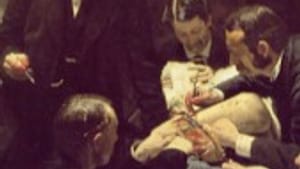Stay in the Loop
BSR publishes on a weekly schedule, with an email newsletter every Wednesday and Thursday morning. There’s no paywall, and subscribing is always free.
Jefferson sells "The Gross Clinic'

On selling 'The Gross Clinic':
It's not cultural, it's strictly business
LEONARD BOASBERG
I don’t see what’s all the fuss about Thomas Jefferson University’s plan to sell Thomas Eakins’s painting, “The Gross Clinic,” to Wal-Mart, with the National Gallery lurking somewhere in the wings.
People are complaining that it’s a Philadelphia icon, been here since Eakins painted it in 1875, part of the city’s cultural history, yada yada yada. As if an artistic masterpiece is more valuable than the $68 million that the university can collect for its plan to expand its campus. You can buy a lot of bricks for 68 million bucks.
As the university’s board chairman, Brian Harrison, put it, “Our first obligation as trustees of the university…is to maximize value.”
I suppose some people will say that Jefferson owes an obligation to the city, where it enjoys police and fire protection and tax benefits, and to the citizens of Philadelphia. I suppose some people will say that a university, even if it’s “not in the business of art education,” as Mr. Harrison points out, owes an obligation to cultural values.
Sure, the board might have offered to sell the painting to local art institutions before contacting art auctioneer Christie’s to work out the deal. The Philadelphia Museum of Art and the Pennsylvania Academy of Fine Arts, while not exactly flush with money themselves, would surely have done their utmost to raise the necessary (as indeed they are right now: Visit www.philamuseum.org). Mayor Street and the City Council, whose devotion to art is so well known, surely would have rushed to join the effort.
But you know, then there would have been an immediate outcry. Remember when the former president of the Barnes Foundation, Richard Glanton, tried to sell some of its paintings and met a chorus of protests from the art world?
No, a deal like this has to be conducted in secret. You don’t even tell all the trustees. To paraphrase the line in The Godfather, “It’s not cultural, it’s business.”
If the sale goes through, the plan is to hang “The Gross Clinic” in the National Gallery until 2009, after which it will go to Bentonville, Arkansas, where the Wal-Mart Foundation, which is so rich it could buy Uruguay, is building a museum.
Which raises an interesting idea. Alice B. Walton, the Wal-Mart heiress, might like to buy a number of other cultural icons. We could offer her the Lipschitz sculpture “Government of the People” across from City Hall, or Remington’s “The Cowboy” on Kelly Drive, or Robert Indiana’s “Love Statue” in John F. Kennedy Plaza. We could start with the "Rocky" statue.
To view other commentaries on "The Gross Clinic," click here and here and here.
To view a response, click here and here.
It's not cultural, it's strictly business
LEONARD BOASBERG
I don’t see what’s all the fuss about Thomas Jefferson University’s plan to sell Thomas Eakins’s painting, “The Gross Clinic,” to Wal-Mart, with the National Gallery lurking somewhere in the wings.
People are complaining that it’s a Philadelphia icon, been here since Eakins painted it in 1875, part of the city’s cultural history, yada yada yada. As if an artistic masterpiece is more valuable than the $68 million that the university can collect for its plan to expand its campus. You can buy a lot of bricks for 68 million bucks.
As the university’s board chairman, Brian Harrison, put it, “Our first obligation as trustees of the university…is to maximize value.”
I suppose some people will say that Jefferson owes an obligation to the city, where it enjoys police and fire protection and tax benefits, and to the citizens of Philadelphia. I suppose some people will say that a university, even if it’s “not in the business of art education,” as Mr. Harrison points out, owes an obligation to cultural values.
Sure, the board might have offered to sell the painting to local art institutions before contacting art auctioneer Christie’s to work out the deal. The Philadelphia Museum of Art and the Pennsylvania Academy of Fine Arts, while not exactly flush with money themselves, would surely have done their utmost to raise the necessary (as indeed they are right now: Visit www.philamuseum.org). Mayor Street and the City Council, whose devotion to art is so well known, surely would have rushed to join the effort.
But you know, then there would have been an immediate outcry. Remember when the former president of the Barnes Foundation, Richard Glanton, tried to sell some of its paintings and met a chorus of protests from the art world?
No, a deal like this has to be conducted in secret. You don’t even tell all the trustees. To paraphrase the line in The Godfather, “It’s not cultural, it’s business.”
If the sale goes through, the plan is to hang “The Gross Clinic” in the National Gallery until 2009, after which it will go to Bentonville, Arkansas, where the Wal-Mart Foundation, which is so rich it could buy Uruguay, is building a museum.
Which raises an interesting idea. Alice B. Walton, the Wal-Mart heiress, might like to buy a number of other cultural icons. We could offer her the Lipschitz sculpture “Government of the People” across from City Hall, or Remington’s “The Cowboy” on Kelly Drive, or Robert Indiana’s “Love Statue” in John F. Kennedy Plaza. We could start with the "Rocky" statue.
To view other commentaries on "The Gross Clinic," click here and here and here.
To view a response, click here and here.
Sign up for our newsletter
All of the week's new articles, all in one place. Sign up for the free weekly BSR newsletters, and don't miss a conversation.